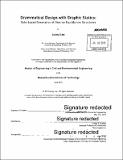Grammatical design with graphic statics : rule-based generation of diverse equilibrium structures
Author(s)
Lee, Juney, M. Arch. Massachusetts Institute of Technology
DownloadFull printable version (23.36Mb)
Alternative title
Rule-based generation of diverse equilibrium structures
Other Contributors
Massachusetts Institute of Technology. Department of Civil and Environmental Engineering.
Advisor
Caitlin T. Mueller.
Terms of use
Metadata
Show full item recordAbstract
During early stages of design, an architect tries to control space by "finding a form" among countless possible forms, while an engineer tries to control forces by "form-finding" an optimized solution of that particular form. Most commonly used parametric tools in architectural design provide the user with extensive geometric freedom in absence of performance, while engineering analysis software mandates pre-determined forms before it can perform any numerical analysis. This trial-and-error process is not only time intensive, but it also prohibits exploration beyond the design space filled with already known, conventional solutions. There is a need for new design methods that combine form generation with structural performance. This thesis addresses this need, by proposing a grammar-based structural design methodology using graphic statics. By combining shape grammars with graphic statics, the generative (architectural) and the analytical (engineering) procedures are seamlessly integrated into a simultaneous design process. Instead of manipulating forms with multiple variables as one would in the conventional parametric design paradigm, this approach defines rules of allowable geometric generations and transformations. Computationally automated random generator is used to iteratively apply various rules to generate unexpected, interesting and yet structural feasible designs. Because graphic statics is used to embed structural logic and behavior into the rules, the resulting structures are always guaranteed to be in equilibrium, and do not need any further numerical analysis. The effectiveness of this new methodology will be demonstrated through design tests of a variety of discrete, planar structures. Grammatical Design with Graphic Statics (GDGS) contributes new ways of controlling both form and forces during early stages of design, by enabling the designer to: 1) rapidly generate unique, yet functional structures that fall outside of the expected solution space, 2) explore various design spaces unbiasedly, and 3) customize the combination of grammar rules or design objectives for unique formulation of the problem. Design tests presented in this thesis will show the powerful new potential of combining computational graphic statics with shape grammars, and demonstrate the possibility for richer and broader design spaces with much more trial, and less error. Key words: grammatical design, graphic statics, shape grammars, structural grammars, conceptual structural design, structural optimization
Description
Thesis: M. Eng., Massachusetts Institute of Technology, Department of Civil and Environmental Engineering, 2015. Cataloged from PDF version of thesis. Includes bibliographical references (pages 129-131).
Date issued
2015Department
Massachusetts Institute of Technology. Department of Civil and Environmental EngineeringPublisher
Massachusetts Institute of Technology
Keywords
Civil and Environmental Engineering.